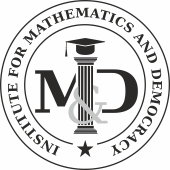IMD Modules in Action
When you picture students excitedly participating in discussions of gerrymandering and equity, the logic of the Electoral College, and the pros and cons of different voting methods, the imagined setting might be a college classroom or a political science conference. But this is precisely what happened in Sarah Nielsen’s 7th and 8th grade math classes in Sunnyvale, California. During the fall 2020 semester, Sarah used IMD’s math and politics modules to design a unit that taught her students about some real-life implications of math on democracy.
Sarah’s unit plan can be accessed here.
Sarah, a graduate of the Swarthmore College’s Math and Education programs, is in her fourth year of teaching middle school in the Bay Area. Inspiration struck when she was looking for ways to bring mathematics closer to the real world: “I am interested in real applications of math, not just made-up word problems,” Sarah explains. With the presidential election only a few months away, she came across the IMD teaching modules, designed by Wellesley College students with the goal of bringing the math behind politics into more classrooms around the country. Sarah worked with two other teachers from the Stanford Teacher Education Program whom she graduated with, Gina Wei and Rayna Smith, to make lessons that focus on math in our political system tailored to their students.
With only a limited time in the classroom that can be dedicated to special topics, she chose to present four exploratory lessons: voting methods, voting turnout, gerrymandering, and the Electoral College. In her lesson on voting methods, the class covered the math behind plurality, majority, and ranked choice voting. For most students, this was the first introduction to the idea that there are different ways to vote. Next, Sarah used the topic of voter turnout to help students learn to read and interpret graphs. Even if this topic may have been less engaging than the others, it easily connected to the data literacy Common Core standard. The most complex topic was gerrymandering, as Sarah used virtual interactive tools to show her students all the ways the population can be divided and the electoral consequences of these choices. Finally, as the election was playing out, the class talked about the Electoral College. The students learned how to calculate the real weight of each vote under the Electoral College, and in the process had many questions regarding the history and equity of the system.
Sarah’s initiative is one of the first of its kind at her school. She noticed that many of her quieter students were more engaged during this unit. One student reflected, “I learned that the systems I thought were fair are not fair at all!” While some may think this interdisciplinary approach is not “real math,” Sarah contests this misconception: “We are doing math. This kind of thinking is math, this kind of problem solving is math.”
Sarah plans to make some adjustments to the lesson plan going forward. Due to the pandemic, her classes were virtual and less frequent during the fall 2020 semester, so she hopes to make this topic even more interactive when she teaches in person again. In terms of the broader context, she likes the idea of more teachers in different subjects helping to teach this content in other classrooms, but sees a general fear of math as a potential barrier to this idea. Additionally, one of the biggest challenges to a broader implementation of these ideas, according to Sarah, is the lack of extra time in the classroom because of strict state testing standards. “Finding a clear connection between each of these topics and the Common Core standards will make them easier to teach,” Sarah says. In the meantime, Sarah is helping IMD make the teaching modules even more accessible to teachers like herself who hope to show their students how mathematics and democracy interact in the real world.




